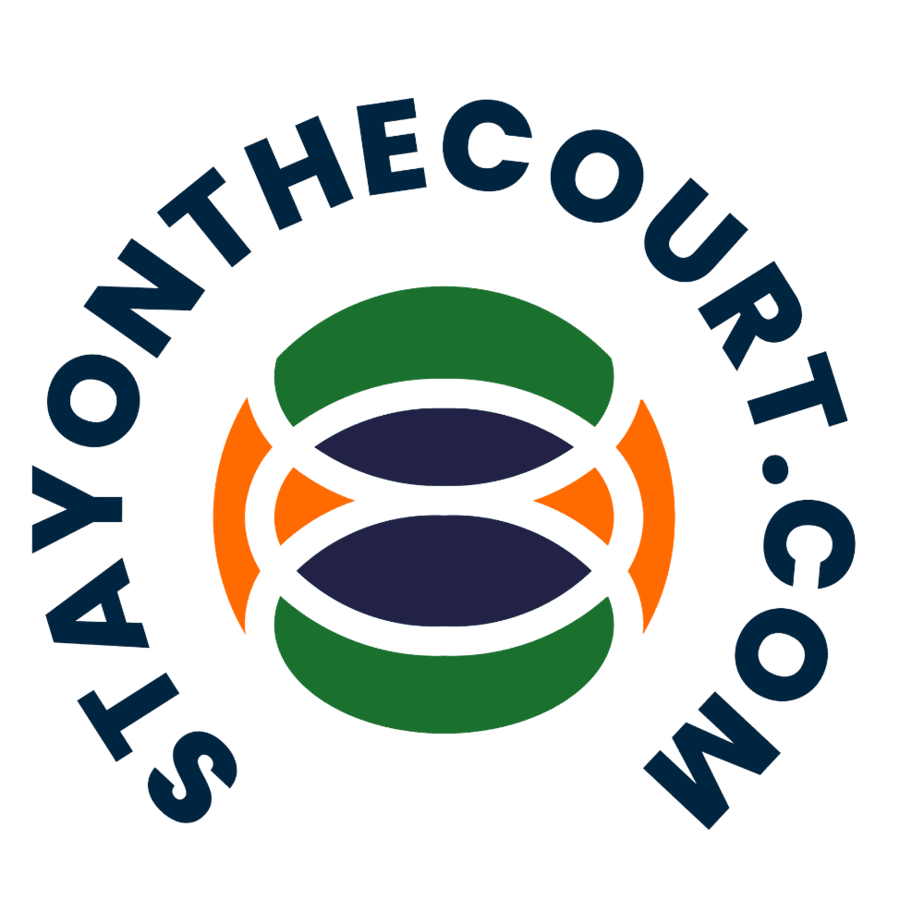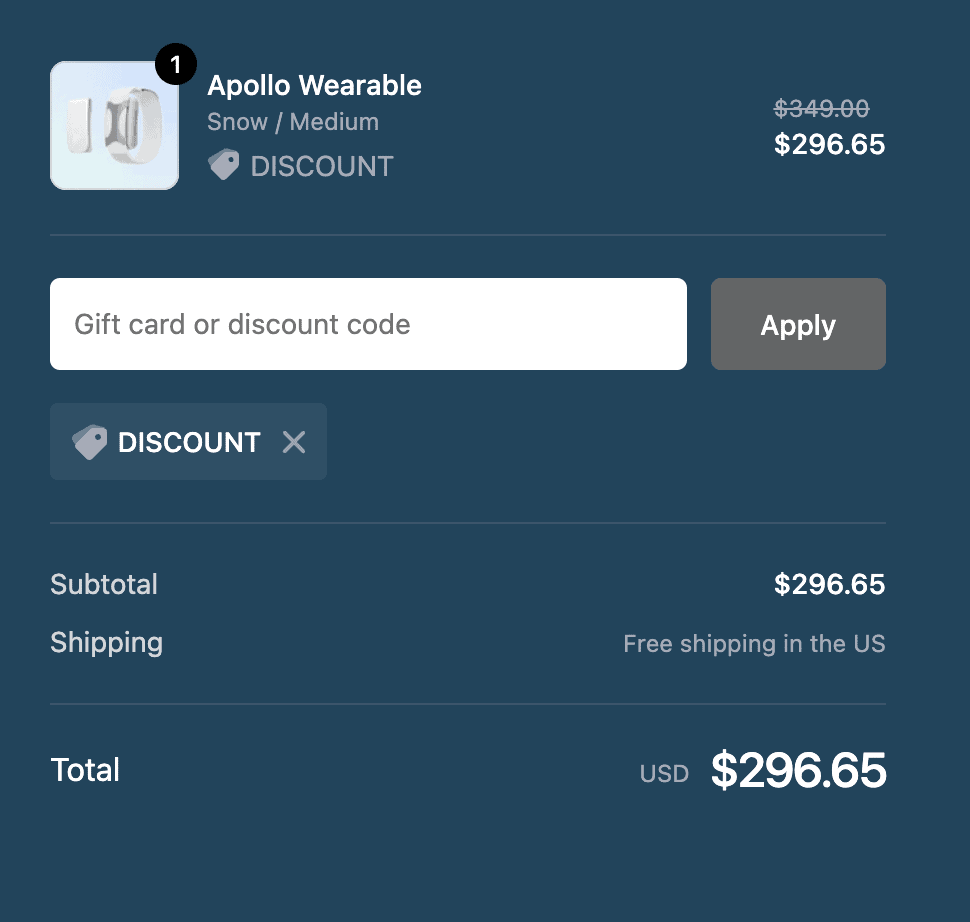Apollo Neuro Review: Benefits, Bad Reviews, Side Effects, And Whether I Still Wear It
Have you ever wished for a magic button that could instantly calm your nerves, boost your focus, or lull you to sleep? Well, I would love one as well. I am still not sure that the Apollo Neuro wearable is that button, but I have owned one for over 3 months now after hearing about it on the Ben Greenfield Life podcast, and continue to wear it daily. In this post, we’ll explore the science behind this innovative device, discuss its benefits, and give you some tips on how to use it effectively. Here are the 3 gigantic things you are going to learn in this Apollo Neuro review.
- Overview of the Apollo Neuro and the science behind it.
- The alleged benefits of the Apollo Neuro device.
- How I use it and what I like and dislike about it and how to buy it at a substantial discount.
For those that want to cut to the chase. Maybe something down the road will take it place. But I have used it for over 3 months and will continue to use it and give it a thumbs up. Actions are always a better indicator than words. For all the details read on.
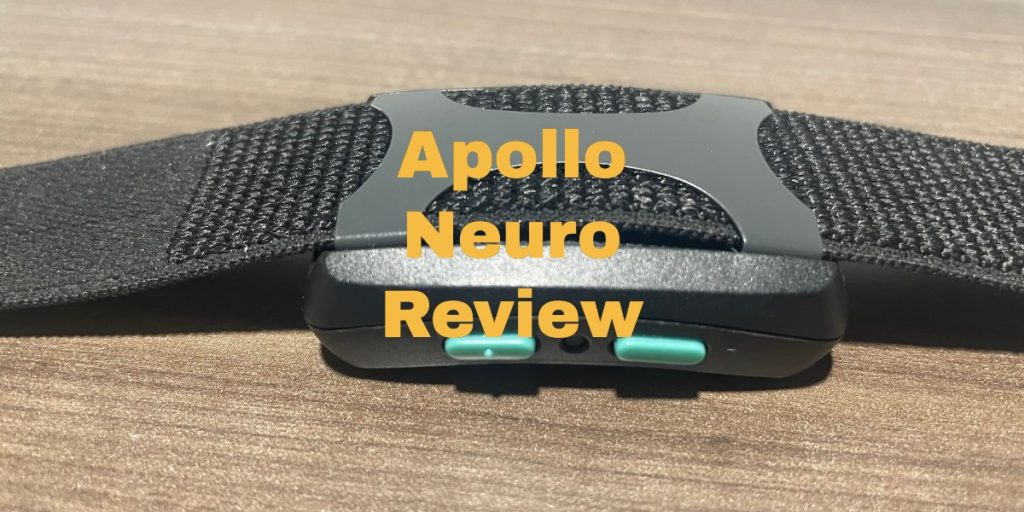
What is Apollo Neuro?
As someone who’s always on the lookout for cutting-edge ways to optimize health and well-being, I was intrigued when I first heard about Apollo Neuro. Created by a duo of doctors, Dr. David Rabin and Dr. Greg Siegle, this wearable device is designed to improve mental wellness by harnessing the power of touch therapy and Heart Rate Variability (HRV).
The Apollo Neuro device is based on the principle of neurostimulation, which is the use of electrical or mechanical stimuli to activate or inhibit the activity of nerves. The device produces gentle vibrations that stimulate the skin and the underlying nerves, which are thought to have an effect on the body’s nervous system.
The Science Behind Apollo Neuro
HRV is a fancy term for the variation in time between your heartbeats. Higher HRV is associated with better physical and mental health, while lower HRV is linked to stress, anxiety, and other ailments. Touch therapy, like a warm hug or a gentle massage, can boost HRV and help you feel better.
The Apollo Neuro device takes this concept and runs with it (or, more accurately, vibrates with it). By delivering gentle, soothing vibration patterns, the wearable aims to improve HRV and promote relaxation, focus, and sleep.
A Brief History of Apollo Neuro
The Apollo Neuro project began as a collaboration between Dr. David Rabin, a psychiatrist, and neuroscientist, and Dr. Greg Siegle, a clinical psychologist. Their goal was to create a non-invasive, drug-free solution to help people manage stress and improve mental wellness. After years of research and clinical studies, the Apollo Neuro wearable was released.
Potential Benefits of Using Apollo Neuro
The Apollo Neuro device promises a range of benefits that could help you live your best life. Let’s take a closer look at some of its most noteworthy perks.
Stress Reduction and Relaxation
The core purpose of Apollo Neuro is to alleviate stress. By sending gentle vibrations to your skin, the wearable stimulates your nervous system and helps you enter a more relaxed state.
Improved Sleep Quality
For those who’ve ever found themselves tossing and turning at night (myself included), Apollo Neuro might just be a sleep aid that works for you. With its calming vibrations, the device could help you fall asleep faster and stay asleep longer. I use this nightly at this point. I generally slept well already, but like to hit the buttons on the device if I wake up during the night. Placebo or not I don’t know but it seems to allow me to get back to sleep more quickly.
Enhanced Focus and Productivity
Ever feel like your brain is running on fumes? Apollo Neuro could help with that too. There is a specific focus vibration pattern you can choose to have the wearable to stimulate your nervous system in a way that promotes focus and productivity. I use this periodically during the workday if I have a 30 or 60-minute focused work project I want to work on. The time just flies by. I don’t have any proof that I am technically more productive but I do feel like I get into a “flow” state more quickly.
Emotional Resilience and Balance
We all have our ups and downs, but Apollo Neuro aims to make the emotional rollercoaster a little less wild. By improving your HRV, the device could help you maintain a sense of balance and emotional resilience.
Physical Recovery and Pain Relief
Finally, Apollo Neuro isn’t just for your mind—it could also benefit your body. The device’s vibrations can aid in physical recovery after workouts and even provide some relief from pain. I use the Recover setting after lifting weights or after my tiger sprints or old-man basketball league games.
How to Use Apollo Neuro Effectively
To get the most out of your Apollo Neuro experience, you’ll need to pair the device with the Apollo Neuro app, customize the settings and modes, and follow a few simple tips for optimal usage.
Pairing the Device with the Apollo Neuro App
First things first, you’ll need to sync your Apollo Neuro wearable with the Apollo Neuro app, available for both iOS and Android. This is where you’ll be able to access and customize the various modes and settings to tailor your experience.
Customizing Settings and Modes
Apollo Neuro offers seven different modes, each designed to address a specific need or situation:
- Energy and Wake Up: Need a pick-me-up? This mode can help invigorate you and jump-start your day.
- Social and Open: Heading to a social event? Try this mode to feel more at ease and connected with others.
- Clear and Focused: Need to buckle down and concentrate? This mode aims to sharpen your focus.
- Rebuild and Recover: Just finished a workout? This mode assists with physical recovery and relaxation.
- Meditation and Mindfulness: Looking for a Zen moment? This mode can help enhance your meditation practice.
- Relax and Unwind: Time to decompress after a long day? This mode can help you let go of stress and tension.
- Sleep and Renew: Ready for some shut-eye? This mode promotes relaxation and sleep.
Examples Of When To Use Each Mode
This table gives you examples of when to use each mode in a given situation.
| Apollo Mode | Example of When to Use |
|---|---|
| Energy and Wake Up | To jumpstart your mornings or combat afternoon fatigue |
| Social and Open | Attending social gatherings, networking events, or meeting new people |
| Clear and Focused | Studying, working on projects, or concentrating on tasks |
| Rebuild and Recover | Post-workout, during physical recovery, or after strenuous activities |
| Meditation and Mindfulness | Enhancing mindfulness or meditation practices |
| Relax and Unwind | Unwinding after a long day or releasing stress and tension |
| Sleep and Renew | Encouraging relaxation, faster sleep onset, and restful sleep |
Tips for Optimal Usage
To get the most out of your Apollo Neuro device, keep these tips in mind:
- Wear the device consistently, either on your wrist or ankle, depending on your preference. Apollo prompts you to try and wear it for at least 3 hours a day.
- Use the appropriate mode for your specific situation, and don’t be afraid to experiment with different modes to find what works best for you.
- Adjust the intensity and duration of the vibrations to your liking. Start with a lower intensity and gradually increase it as needed. I find that I need to ratchet up the intensity on most modes.
My Real-life Experiences Using The Apollo Neuro
All I can give you is my anecdotal evidence of what works for me. You can check their website for research-backed results from clinical studies that have demonstrated the potential benefits of using Apollo Neuro, including improved focus, better sleep, and reduced stress. I will start with what I don’t necessarily like about the device.
What I Don’t Like
Battery Life Could Be Better
If you are going to wear the device at least 3 hours a day you are likely going to have to charge it daily. Especially, if you crank up the intensity like I do. That can be a little annoying but it does charge pretty quickly (less than 2 hours to a full charge in my experience).
Constricting On The Ankle
I wear it as often as I can on the ankle since that is their recommendation for optimal use. I still wear it daily so it must not be that big of a deal, but I don’t like anything constricting my ankles and blood flow (especially that far down my leg).
Looks Like You Are On House Arrest
If you wear the device on your ankle (which is recommended) it looks like a house arrest ankle bracelet (not that I have firsthand experience). But, if you are around your non-bio-hacker buddies you may take some ribbing and spend 15 minutes describing why you use it.
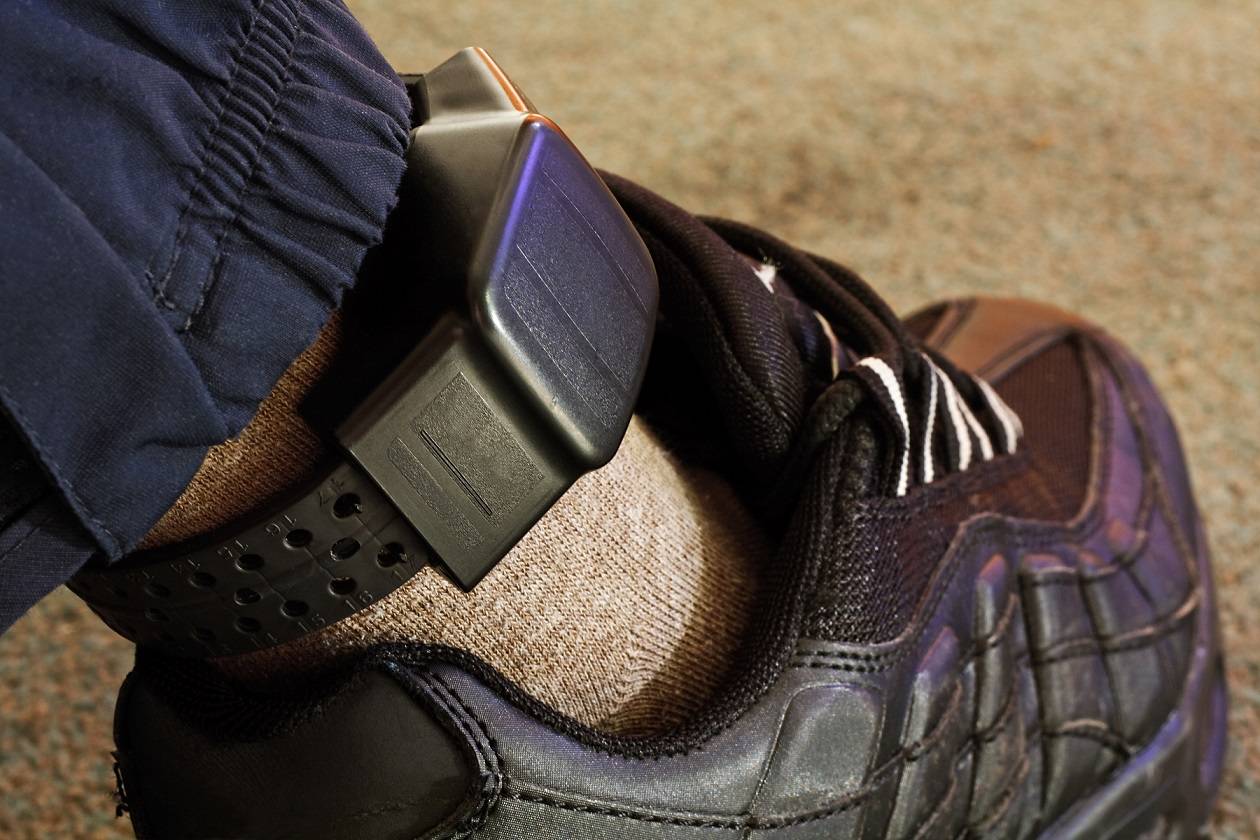
This is a house arrest ankle bracelet (not me).
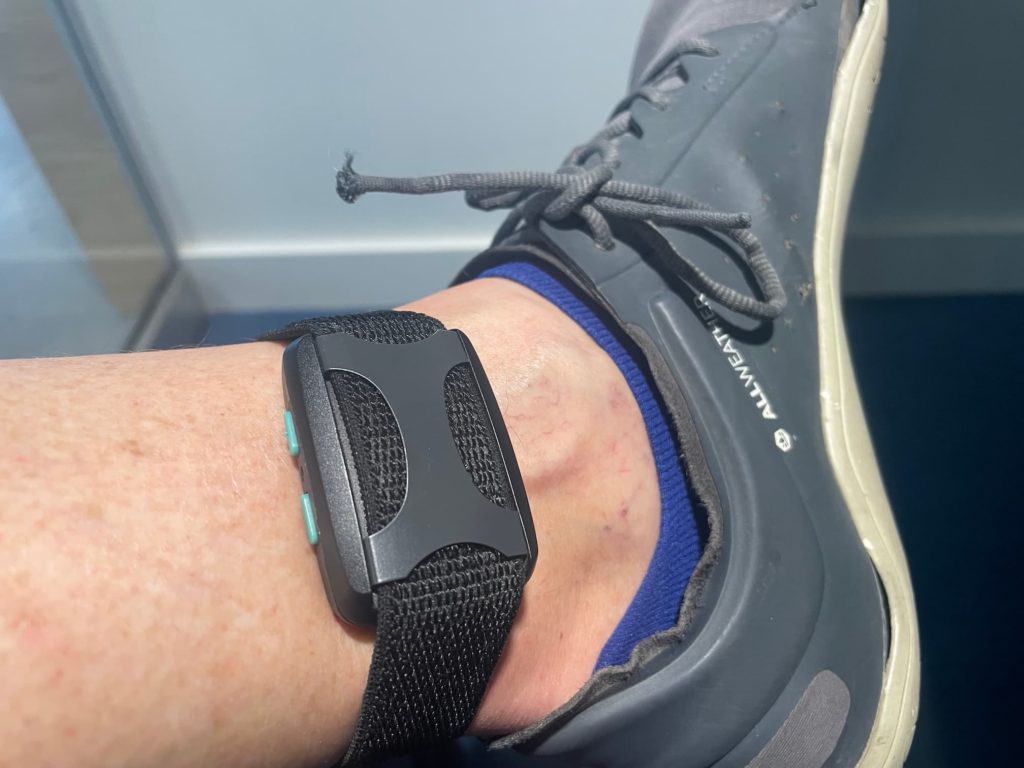
This is my Apollo Neuro on my ankle.
My Wife Didn’t Adopt It
I had hoped my wife would like it for winding down in the evenings and to help her with sleep. She thought it was OK, but didn’t like it enough to buy another one for herself. She is not a fan of wearing something else to sleep. She already has an Ooler\Chilipad in the bed.
How Would I Know It Was Broken
Unless it no longer turns on at all, how would I know it was broken? This is something I may ask their customer service folks. Could the device get off kilter and start vibrating at the wrong frequency for the stated program (Energy, Social, Recover, etc.)? I don’t think it would be possible to diagnose that. I would just keep wearing it. If I can find an answer I will update the post.
What I Like
The App Interface Ease Of Use
You have nice big times in the app for each setting. You just choose the one you want and then it asks you how much time you want from 14 minutes to 2 hours. Just press play and away you go. Then, if you want to rerun the program you can just click two buttons on the actual device and it reruns it without having to get into the app. Very handy if you wake up during the night and you want to rerun “Fall Asleep” mode.
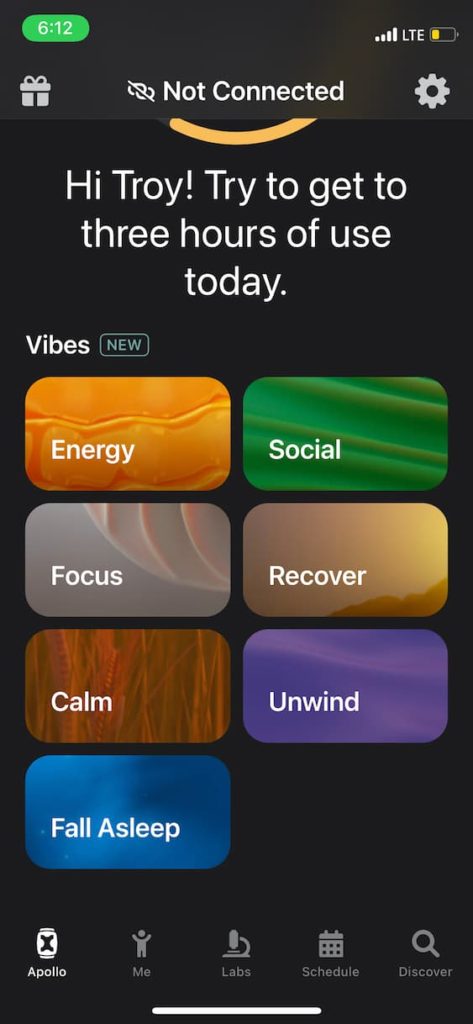
Energy Mode
If I wear the device to bed, I will normally turn on the “Energy” mode when I wake up. It gives you a little lift and a “zingy” feeling. It is one of the couple of setting where I really feel it working. Here is Rabin’s explanation:
Right, exactly. So, that would be something that people use first thing in the morning. And many people use it instead of caffeine or stimulants, which is interesting. I started mostly drinking decaf coffee and decaf tea as a result of using this, which is nice. And then, when I need caffeine, it works a lot better for me.
Dr. David Rabin, MD, PhD on Ben Greenfield Life Podcast
Fall Asleep Mode
I have been using this most nights to go to sleep. I sleep really well to start and have been tracking my sleep with an Oura ring for years (and more recently I added a Whoop Band) so it is hard to detect any tangible difference in sleep scores. But, I would say I have been going to sleep even more quickly since I have been using it. No nights ruminating over some stressful thing for the day. I also like being able to turn it on again if I wake up in the middle of the night.
It Is Quiet
The Neuro works by using sound waves that vibrate to facilitate the state you want. I was afraid it would either be too loud or vibrate too much and wake up my wife when I used it during sleep. But, I am on month 3 and there have been no complaints so far. I typically use it at a 56% intensity during sleep. That being said, we have a good mattress that dampens movement which may help on the vibration side.
Focus Mode
As I eluded to earlier, I use the Apollo Neuro occasionally, during my workday, if I am faced with a 30 or 60-minute project that demands my full attention. In these instances, I’ve noticed that time seems to fly by effortlessly. While I can’t provide concrete evidence of increased productivity, I do feel that using Apollo Neuro helps me enter a “flow” state more rapidly, allowing me to maintain on the task.
What Mode To Use During Certain Times of the Day
I have experimented with every mode but I consistently use Energy and Sleep. Then use Recover, Focus, and Unwind periodically throughout the day but am not as consistent. The table below gives you an idea of what time of day I use each mode.
| Apollo Mode | Time of Day to Use |
|---|---|
| Energy and Wake Up | Early morning or during afternoon slumps |
| Social and Open | During social hours, lunch breaks, or after work |
| Clear and Focused | Morning or afternoon work sessions |
| Rebuild and Recover | Immediately after physical activities or workouts |
| Meditation and Mindfulness | Morning or evening meditation sessions |
| Relax and Unwind | Late afternoon or early evening |
| Sleep and Renew | At bedtime or when preparing for sleep |
Apollo Neuro Bad Reviews
I didn’t look at many reviews before buying the Apollo Neuro. But the ones I did review on YouTube were very neutral. I wouldn’t say they were bad reviews, but essentially saying that it wouldn’t be the first wearable they would buy if they only had 400 dollars to spend. I would agree with that. If you don’t have a Whoop Band or Oura Ring or other high-quality sleep trackers I would go there first. But, I also don’t have noticeable issues with anxiety which is one of the focus points of the Neuro.
Here are excerpts from 3 health gadget YouTube reviewers that I think generally do a thorough job. Most influencers like this have some sort of referral relationship with the vendor but I think these are fair and unbiased reviews:
Gemma Evans Review
This is Gemma Evans’s final summary from her YouTube review:
In my first review of the Apollo, I told you that it was hard to tell whether my life was better with it than without it, and I’d have to say I stand by that conclusion today.
Gemma Evans from HealthHackers.org
Katie Moore’s Review
I would consider Katie Moore’s (aka Katie Type A) review as an overall positive, but I did pull out some things that she did not like about the device:
I’ve got to be honest with you guys, the weirdest thing was wearing this big, bulky device on your ankle around the house. Especially as I’ve been working from home and I don’t get out a lot, it really did feel like a home arrest ankle bracelet, so that was weird. It definitely was a little clunky wearing it on my arm for long periods of time while writing or typing. Now, I will warn you, this thing is expensive—it’s $350, and it’s not going to track your sleep or your fitness, and it’s not even a watch.
Katie Moore from KatieMoore.io
Shervin Shares Review
For context, this review is from 3 years ago. Shervin puts good music into his video reviews and they are entertaining. I would call his review overall negative mainly because he didn’t like the price point. He does go on to say it is a great device if you have the extra budget.
And I also don’t have enough money for it right now, which brings me to the last point: the price. It’s pretty expensive at $350…
Shervin Shares Review
Is this really a device you actually need? Is it going to help your life that much? Personally, not for me right now.
So, it comes down to whether you should buy this. It shouldn’t be a matter of “Is this too expensive?” but rather “Am I getting enough value out of this device for the price?” If I were to ask that question for this, I honestly don’t think so, given my budget. However, if you have the money, this is a great device if you’re trying to get that extra 10 percent…
Other Bad Review Factors
Apollo Neuro is a relatively new product, and its long-term effects and potential risks are not well-understood. Some additional potential cons of using an Apollo Neuro device may include:
- Lack of scientific evidence: While the device’s manufacturer claims that it can provide a number of benefits, there is currently a lack of independent scientific research to support these claims.
- Cost: The device is relatively expensive, which may be a barrier for some individuals.
- Potential for side effects: As with any device that stimulates the nervous system, there is a risk of side effects such as headaches, dizziness, and nausea.
- Unproven effectiveness: The device’s effectiveness for the treatment of specific conditions is not yet established and it’s not FDA-approved.
- Device size and comfort: The device is worn on the skin and its size and shape could be uncomfortable for some users.
It’s important to note that most of the information regarding the cons of the device is based on the lack of scientific evidence, and further research is needed to fully understand the potential risks and side effects associated with the use of an Apollo Neuro device.
Comparing Apollo Neuro to Other Stress-Reduction Wearables
While Apollo Neuro is an interesting device, it’s not the only player in the stress-relief wearable game. To help you make an informed decision, let’s compare it to some other popular options:
| Device | Key Features | Price |
|---|---|---|
| Apollo Neuro | Vibration patterns, HRV improvement | $349 |
| Spire Stone | Breath tracking, stress detection | $149 |
| Muse 2 | EEG brain-sensing, real-time feedback | $399 |
I have not used the Spire Stone or the Muse 2 but I thought having the pricing comparison for context was helpful. I have heard Greenfield talk about Muse 2. But it is worn on the head and I know I wouldn’t wear it regularly. You can normally find a 15% or $50 discount on the Apollo Neuro to bring the price down closer to $300.
Apollo Neuro Discount Code
I plan to do a separate post about this in the future. Most recently I checked the coupon code DISCOUNT and it was good for a 15% discount. I will keep this up to date with any new discount codes I get. They also normally run promotions around all the major and minor holidays. If you can get 50 bucks knocked off you will be getting very close to their best deal. Clicking the image below will take you to their site.
Conclusion and FAQ
I appreciate you taking the time to read my Apollo Neuro review and hope it was helpful in either making your decision to buy one or in using it if you already own one. Remember to check the DISCOUNT code to see if you can get the deep deep discount. I researched some questions I had and posted the answers below.
Is it safe to use?
Yes, Apollo Neuro is safe to use. It’s a non-invasive, drug-free device that uses gentle vibrations to stimulate the nervous system.
How long does the battery last?
The battery life of the Apollo Neuro device typically lasts for about three days on a single charge. If you use it a higher intensities and longer periods of time you will have to charge it more often.
How long does it take for Apollo Neuro to work?
Dr. Rabin of Apollo Neuro claims that the device can provide benefits within minutes of use, but the optimal duration and frequency of use will vary depending on the individual and the specific condition being treated.
What does Apollo Neuro feel like?
Apollo Neuro produces gentle vibrations, similar to light massage. The vibrations are designed to be comfortable and soothing. The device is worn on the skin, typically on the inside of the wrist or ankle, and can be adjusted to different vibration patterns and intensities. Some people might describe the sensation as a gentle tingling or a mild buzzing feeling.
Troy Wallace
Troy Wallace is Certified Basketball Speed Specialist and shares his experiences in trying to stay as healthy as possible to stay on the court. He is active in coaching youth basketball in YMCA, Team Work Sports Nebraska, and, currently, in the Jr. Warriors program in Omaha, NE. Visit Troy's Full Author Bio Page or email him directly.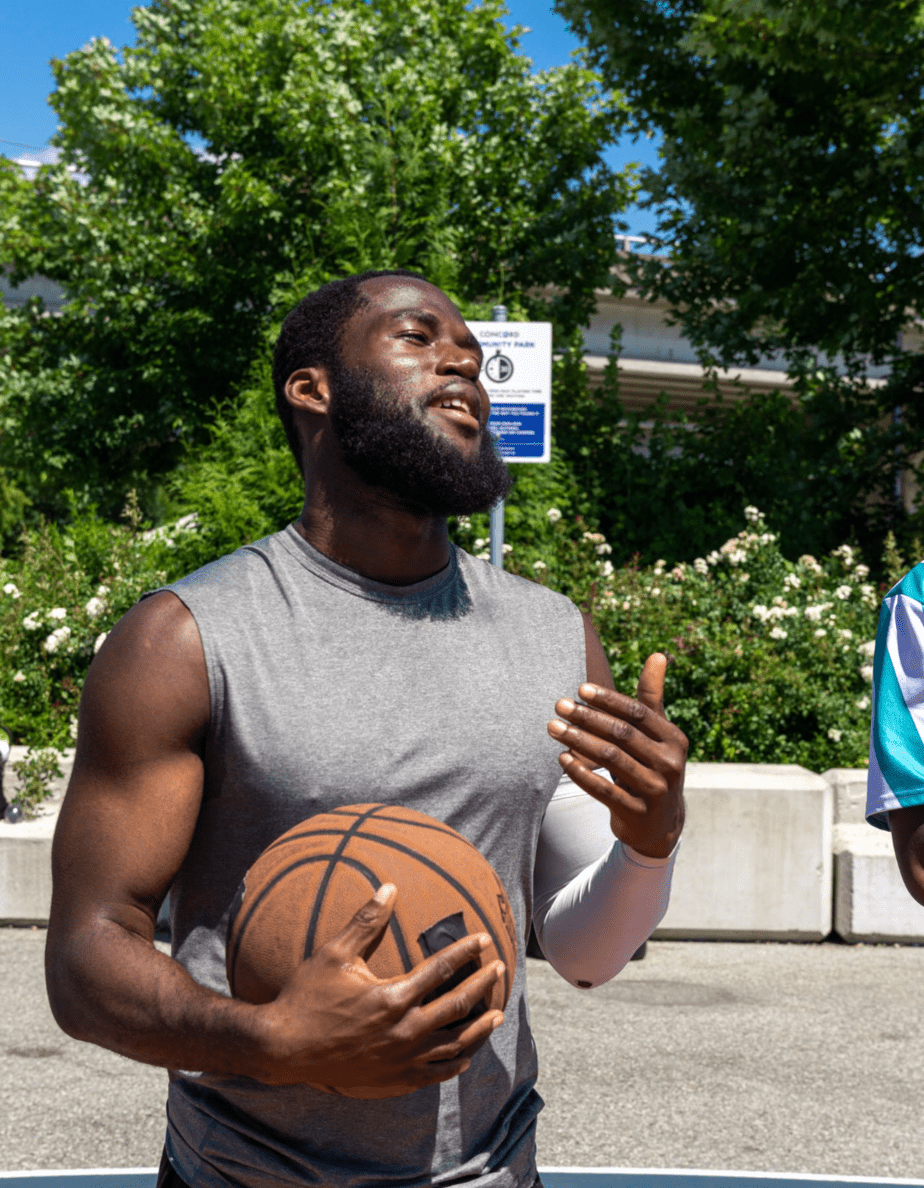
Meaningful conversations happening daily about training, recovery, and injury-specific rehabilitation as well as sport-specific discussions on playing, coaching and refereeing your favorite sport. We welcome experts and those with curious minds seeking answers.
Join The Stay On The Court Community!